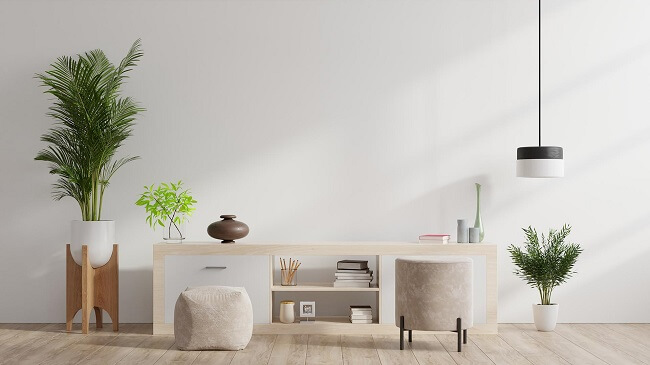Our Top 10 Picks For The Best Indoor Houseplants
Table of Contents
Indoor houseplants have been an integral part of almost all interior design styles for the last few decades at least, but recently they have enjoyed an unprecedented boom in popularity. They’re not just a great design choice, however. Indoor plants also boast a myriad of health and wellness benefits, from boosting your mood and improving concentration and productivity, to absorbing carbon dioxide and purifying the air in your home.
There are hundreds, if not thousands, of plants that are grown as indoor plants today, from tropical ferns to air plants, each with its own set of benefits and drawbacks. With so many options, it may be difficult to choose the right plants for you, especially if you’re just starting out. To help you navigate the lush world of indoor plants, we’ve put together a list of our top ten picks for the best indoor house plants. All of these plants have been chosen for ease of care and budget-friendliness, and most are suitable for beginners. Keep reading to find the best houseplants to add a bit of nature, serenity, and clean air to any room in the house.
Chinese Evergreen (Aglaonema)
With dramatic patterned leaves and thick foliage, the Chinese Evergreen is a fabulously beautiful plant with a slow to moderate growth rate. It comes in seemingly endless varieties, each with its own unique leaf shape and pattern. These plants are ideal for keeping indoors, as they aren’t particularly fussy about light and adapt well to low light conditions. They are particularly forgiving and can withstand over- and under- watering from time to time (a common mistake made by novice plant owners), though they should only be watered when the soil has fully dried from the previous watering. Smaller specimens can be a perfect addition to an end table, while larger plants are great as a lush floor plant.
Snake Plant (Dracaena Trifasciata)
Featuring snake-like leaves in a plethora of patterns, the snake plant’s striking appearance has made it a popular choice both inside and outside of the home. These plants grow rather slowly, especially when kept indoors, and only require an occasional watering. Snake plants are actually a type of succulent, and are a perfect houseplant for those who find themselves struggling to keep up with a regular watering schedule. These plants do best in indirect sunlight, but will tolerate lower light conditions. It is best not to keep them in areas with prolonged direct sunlight, however, as this may cause the leaves to burn. When watering, make sure that the soil has had the chance to dry almost completely, and water the soil around the plant only – watering the plant itself can waterlog the plant, resulting in internal rot and, eventually, a dead plant.
Pothos (Epipremnum Aureum)
The lush Pothos, with its trailing tendrils and heart-shaped leaves, comes in countless varieties. It has been a favorite of interior decorators for decades, and with good reason – this plant is readily available, cheap, and extremely adaptable. With proper care these plants can grow rather quickly. Pothos plants do best in indirect sunlight, but will also enjoy short periods of direct light. Very low light conditions can negatively impact the plant however, slowing its growth and even affecting its variegation. Water your Pothos with a thorough soak when the soil has dried, and make sure that it’s potted in a container that will allow for proper drainage of excess water. These plants do great as hanging plants due to their elegant, fast-growing vines.
Spider Plant (Chlorophytum Comosum)
Summed up in one word, these plans are hardy. They are the perfect indoor plant for beginners because they are nearly impossible to kill. They are best kept next to a bright window with ample natural light, but these plants will tolerate very low light conditions as well. They do well with an average watering schedule of every 2 weeks or so – just water when the soil is nearly dry. Spider plants will handle the occasional under- and over-watering without too much fuss, but if the plant becomes too stressed it may produce “babies” – literally little versions of themselves that develop their own little root systems. Or, in other words: free plants. Even without sufficient neglect becoming of a new plant owner, you can expect your Spider Plant to produce a few babies a year. They are absolutely adorable and very easy to propagate: simply snip off and stick in some soil. And finally, best of all, these little plants are the undisputed champions of indoor plant air purification!
Fiddle Leaf Fig (Ficus Lyrata)
Sporting large violin-shaped leaves in a striking deep green, Fiddle Leaf Figs are a perfect choice for those looking for a plant with dramatic presence. The Fiddle Leaf Fig is a tree native to the tropical regions of western Africa, and as such enjoy warm and humid environments. Given the right conditions, these plants can be fast growers, to the point of needing to be repotted annually. Keep your Fiddle Leaf Fig as a floor plant to allow it sufficient vertical room to grow, and away from anywhere where the temperature could drop quickly, like in front of AC vents. It’s a bit more challenging on the watering front than our previously mentioned plants, and will require a constantly moist – but not soggy – soil in order to thrive. To keep your Fiddle Leaf Fig healthy, make sure to keep its leaves clean by using a damp towel to wipe off accumulated dust every few weeks.
Rubber Tree (Ficus Elastica)
A vibrant plant with glossy, rich green leaves and a burgundy undertone, it’s easy to see why the Rubber Tree has become so popular amongst indoor plant enthusiasts. Like the Fiddle Leaf Fig, the Rubber Tree is a ficus native to the tropics. It requires bright indirect natural light and is sensitive to sudden drops in temperature. Keep away from AC vents and cold windows, and maintain consistently moist soil. These plants benefit from regular feedings during the summer months to encourage growth. Do not allow the plant to become root bound, however, and keep an eye out for suddenly slowed growth, legginess, or discolored leaves that may indicate that the plant is stressed.
ZZ Plant (Zamioculcas zamiifolia)
Another tropical Africa native, the ZZ Plant, also know as the Zanzibar Gem, features vibrant green leaves in a neat geometric arrangement that result in a tidy and elegant look. These plants are not terribly fussy about watering thanks to their rhizome structures, which are able to store water for months. They prefer to be watered once their soil has completely dried, but as a drought resistant plant, they will be just fine if you forget them for a week or two. ZZ Plants thrive in indirect bright natural light, but will tolerate lower and even artificial lighting conditions. They should not be kept in direct sunlight, however, as this can burn the leaves. In insufficient light they may become leggy. Like the Fiddle Leaf Fig and Rubber Tree, this tropical plant is very sensitive to the cold, and should be kept in a consistently warm spot in the house. While they are generally not fussy, ZZ plants do prefer humid conditions and may be sensitive to dry air. If you live in a very dry and arid climate and your ZZ Plant begins showing signs of stress, consider placing a tray of water beside it to add more moisture to the surrounding air.
Peace Lily (Spathiphyllum Cochlearispathum)
Hailing from the tropical rainforests of South America, the Peace Lily is a leafy green plant with striking cream-colored blooms. As a tropical plant, they thrive in soil that is consistently moist (not soggy!). They prefer bright, indirect natural light, but keep them protected from direct sunlight as it can scorch their delicate foliage. Peace Lilies prefer warm temperatures, and are very susceptible to the cold. Keep them in a warm part of the house, away from drafts and AC vents. They are air purification powerhouses, absorbing and neutralizing toxic compounds like formaldehyde and carbon monoxide. To keep your Peace Lily healthy and thriving, mimic its natural tropical habitat by misting it regularly. If possible, keep your plant in a humid environment with the help of a humidifier. Finally, feed your Peace Lily weekly during the summer months, and ensure that it is potted in rich, nutritious soil.
Prayer Plant (Maranta leuconeura)
The Prayer Plant, so named due to the fact that it folds its beautifully patterned leaves during nighttime, is a striking plant native to Central and South America. It’s a slow and low growing plant, and slightly more difficult to care for than the previous plants on our list. Prayer Plants require well-draining soil, that must be kept consistently moist during the summer months. In winter, keep the soil drier, as the plant enters its dormant stage during this time. Water with lukewarm water, and mist regularly to mimic the plant’s natural humid environment. It is sensitive to the cold, and should be kept in a warm area that hovers around 70 degrees year-round. Keep in an area with plenty of bright indirect sunlight, and away from direct sunlight that can burn the plant’s delicate leaves. Because of their slow growth rate, Prayer Plants should be purchased at their desired size from the start.
Zebra Plant (Aphelandra Squarrosa)
Native to southeastern Brazil, this tropical plant earned its name due to the striking contrast between the rich green leaves and their dazzling veins. Like its other tropical counterparts, the Zebra Plant thrives in conditions that mimic its tropical origins – moisture, humidity, diffused bright light, and rich soil. It enjoys frequent misting, and benefits from watering with warm water. If properly cared for, the Zebra Plant blooms in late summer or early autumn, producing vibrant golden yellow flowers that last approximately one month. Repot annually to encourage consistent and healthy growth. Zebra Plants are considerably more delicate and require more care than the hardy plants at the top of our list, but with dedicated care and maintenance they will thrive and produce their beautiful blooms year after year.

